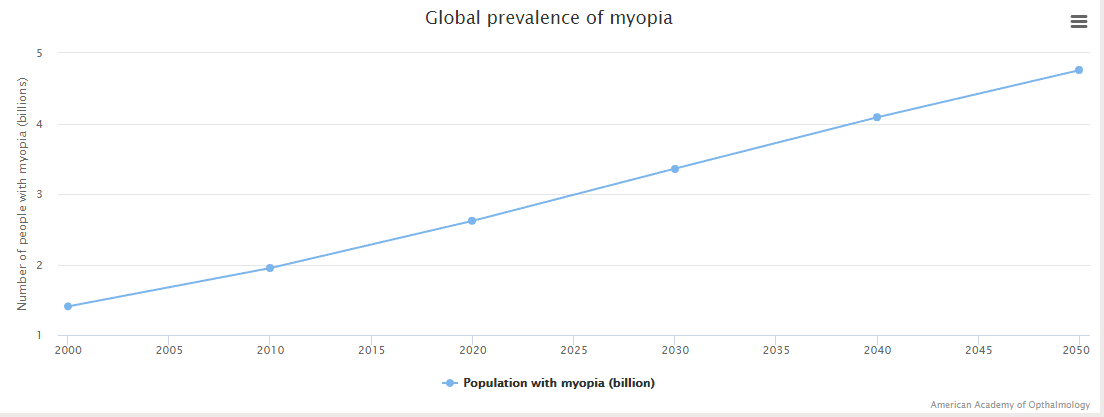
By 2050, nearly half of the world’s population — about 4.8 billion people — may develop myopia (近视), a dramatic rise from current levels. The problem is most severe in East Asia, South East Asia and Asia-Pacific, where by 2050 around two thirds of the population of these regions will be short-sighted. Not far behind will be North America, with 58.4%, Western Europe with 56.2% and Australasia with 55.1%.
While genetics influences myopia, lifestyle changes such as “the excessive use of near electronic devices” can accelerate the development of myopia. According to a study, many of the countries with the highest levels of smartphone ownership — such as South Korea and Australia — fall within the regions likely to have the highest levels of short-sightedness in the coming decades. However, while there’s a correlation between increased use of screens and increased prevalence (盛行) of myopia, it is unlikely that screens on their own are the problem.
The Ophthalmology study blames the increase in short-sightedness on “a combination of decreased time outdoors and increased near work activities”. However, studies have found that children who spend more time outdoors are less likely to suffer from myopia. Similarly, an Australian study which lasted for three years and involved more than 4,000 children in Sydney primary and secondary schools found that children who spent less time outside were at greater risk of developing myopia.
It is not yet known exactly why time spent outdoors is so important in preventing the condition. However, Ian Morgan of the Australian National University in Canberra has studied rates of short-sightedness across Asia and Australia, and claims it comes down to the way in which light (or lack of it) affects the development of the eyeball. Exposure to sunlight cuts myopia rates by encouraging the release of dopamine (多巴胺). Dopamine is known to inhibit eye growth and myopia is a condition caused by excessive eye growth.
原创编写 版权所有 侵权必究! 每日更新 个性化阅读 英语飙升!
1.1. Which region will have the second-highest myopia rate by 2050?
A North America.
B Western Europe.
C Australasia.
D East Asia.
解析:选A。细节理解题。根据第一段数据排序:东亚/东南亚/亚太地区最高(三分之二,即约66.7%),北美次之(58.4%),其后是西欧(56.2%)和澳大拉西亚(55.1%)。故选A。
2.2. What can we know from the second paragraph?
A Smartphones are the primary cause of myopia.
B Reducing smartphone use will completely prevent myopia.
C Screen use alone cannot fully explain rising myopia rates.
D Countries with high smartphone ownership have low myopia risk.
解析:选C。推理判断题。根据第二段中的“while there’s a correlation between increased use of screens and increased prevalence of myopia, it is unlikely that screens on their own are the problem”可知,尽管屏幕使用增加与近视率上升存在关联,但近视问题不太可能仅由屏幕本身引起,暗示其他因素(如户外时间)也起作用。故选C。
3.3. What do the Ophthalmology study and the Australian study have in common?
A They focus on the role of electronic devices.
B They show reduced outdoor time increases myopia risk.
C They prove that dopamine can prevent myopia.
D They suggest that lack of light is the main cause of myopia.
解析:选B。细节理解题。根据第三段中的“The Ophthalmology study blames the increase in short-sightedness on ‘a combination of decreased time outdoors and increased near work activities’.” 以及“Similarly, an Australian study... found that children who spent less time outside were at greater risk of developing myopia.”可知,两项研究都表明户外活动时间少会增加近视的风险。故选B。
4.4. What does the underlined word “inhibit” probably mean?
A Prevent.
B Promote.
C Change.
D Support.
解析:选A。词义猜测题。根据最后一段中的“Dopamine is known to inhibit eye growth and myopia is a condition caused by excessive eye growth.”可知,因为近视是由眼球过度生长引起的,而多巴胺能“inhibit”眼球生长,由此可推测“inhibit”的意思是“阻止,抑制”,与prevent意思相近,故选A。